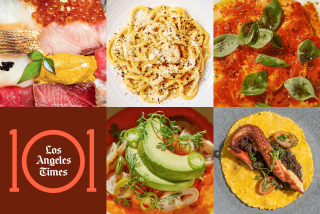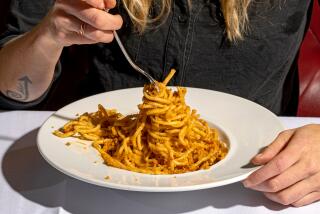Bennett: Cold-brew coffee like you’ve never tasted
The Brauhaus is the only company around that is kegging and bottling Kyoto-style cold brew coffee for wholesale and retail sale.
Walk into The Brauhaus’ light industrial storefront on the eastern edge of Santa Ana, and you may think you’ve stumbled into a mid-century modern interior design showroom.
Simple, low-slung furniture pieces line the minimal front office, where owner Will Huttner sat recently at a white desk, researching local cafes that might be in need of his company’s services.
In the back warehouse is an immaculate seating area set up like a retro-future living room — a smooth-lined, gray sofa with teak accents anchors a scene flushed out by a black floor lamp, curved wooden end tables and a garden of indoor plants. On the wall are canvases printed with snippets of the New York City subway system map, a marvel of modern graphic design. The coffee table is covered with books about Dieter Rams, Massimo Vignello and Bauhaus, the German art school that pioneered the marriage of form and function, from which The Brauhaus gets its name.
But have a seat on the aforementioned couch and you’ll stare directly into the real reason for this ode to clean, modern design: a custom-crafted brewing rig that churns out not beer but coffee.
And not just any kind of coffee either. The Brauhaus’ entire coffee operation revolves around an intense attention to detail, which means that for the last year or so it has been turning direct-trade, single-origin beans from local roasters into 50- to 100-gallon batches of Kyoto-style cold brew.
Visit Huttner at his office, which doubles as a miniature pop-up coffee shop, and he’ll gladly pour you some of the almost whiskey-like result from his two-tap kegerator, letting the concentrated liquid flow over an ice cube in a highball glass. You will want to sip slowly and let it open up, like a good Scotch.
“Our tagline is ‘form, function and brewing,’ which I think that aids a lot in our transparency,” Huttner says, noting that transparency for The Brauhaus includes sharing with customers not only the roaster and the country of origin for each batch (last week it brewed No. 41), but also the type of bean, the washing process, the elevation at which it was grown and specifics about the brewing itself.
“There’s no fluff, there’s no filler. It’s as simple as what’s in your glass, and even then, there’s way more depth to this than a lot of people notice at first.”
Most cold coffee that you’ll drink to stay caffeinated during these sweltering summer months is made one of two ways: brewed hot first and then poured over ice (iced coffee) or by leaving the grounds to steep with water overnight, likely at room temperature in a food-safe bucket retrofitted with a spigot on the side (cold brew).
The latter method, also called Toddy or full-immersion, doesn’t sound very attractive, but it does well for restaurants and shops (and even smaller companies bottling for retail sale) that want to serve the growing demand for cold brew by creating the increasingly desirable, less acidic flavor and balanced smoothness that comes when coffee grounds don’t hit hot water.
Huttner says that often, though, he discovers that (specialty and boutique coffee shops aside) this type of cold brew is being made from beans that have been sitting around for a while or from varietals that are less desirable, turning out lots of full-bodied, highly caffeinated, chocolately cold brews that lack the character he knew to be inherent in many specialty coffees.
“It’s being sold as, ‘Here, this is coffee, it’s less acidic and has a lot of caffeine and you can keep it in your fridge,’ ” he says of the restaurants, cafes and shops he has visited. “It was and still is for the most part a convenience product. You need to wake up in the morning, so drink this. No one’s talking about how they’re brewing it, and no one’s talking about what beans they’re using.”
Huttner — who dabbled in craft beer, an activity where even home brewers are told the origin of their hops and can nerd out which farms grow specialty grains — knew there had to be a better way.
He discovered Kyoto-style drip, technically a take on cold brewing but a process in a world all its own. It’s made using a wood-framed tower-like apparatus that seems more fit for a steampunk-era drug lab than a coffee shop (perhaps you’ve seen the one at Portola Coffee Labs?), and creates a closed system that allows for far more control and results in better flavor clarity. Similar to the hot-brew, pour-over method, grounds are put into a middle cylinder and cold water slowly drips through it, releasing one painstaking drop of cold brew at a time into the receptacle below.
Huttner bought some bags of beans from local roasters like Kean, Augies and Bodhi Tree and experimented with this popular Japanese method at home. He quickly saw an opportunity to bring more transparency to the larger cold-brew market, so he recruited his friend Ryan Aquino to help with branding and bean selection, and together they launched The Brauhaus.
“It’s pretty crazy what coffee can do if you really try to make a product to show it off,” he says.
Using equipment usually sold to small beer breweries, Huttner built a fully controlled, automatic, industrial-sized Kyoto-style cold-coffee brewery, which allows him to scale up the few precious gallons at a time that are made by using the traditional towers and instead produce (16 hours at a time) batches large enough for a wholesale business.
While he’s in the process of procuring some contract brewing accounts for local cafes that don’t have the infrastructure to make their own quality cold brew, he’s currently keeping shops like Costa Mesa’s Neat Coffee with a constant keg supply and has enough left over for growler and bottle sales, for now made exclusively through the Santa Ana storefront.
The Brauhaus is unique in kegging and bottling this highly nuanced form of iced coffee and offering it wholesale and retail. It’s also the best damned cold brew in Orange County.
And though all the preoccupation Huttner has for sourcing, process and presentation might seem a little obsessive just to make a cup of joe, his motivations are best explained by product designer Rams, who’s most famous quote is auspiciously bookmarked inside one of the hardcovers resting on the coffee table in The Brauhaus’ “living room.”
“My heart belongs to the details,” it says. “I actually always found them to be more important than the big picture. Nothing works without details. They are everything — the baseline of quality.”
More to Read
Eat your way across L.A.
Get our weekly Tasting Notes newsletter for reviews, news and more.
You may occasionally receive promotional content from the Los Angeles Times.






